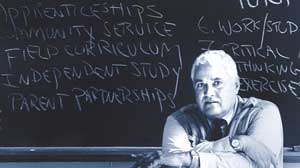The Stage Is Set
With the American educational stage set as described above, a 1970 report by the Joint Commission on Mental Health of Children entitled “Crisis in Child Mental Health: Challenge for the 1970s” stated that a primary responsibility of schools was “personality development.” The commission recommended an overhaul of the public school system.
“The changes to be enacted,” the report stated, “involved all aspects of the school milieu — curriculum, teaching methods, teacher-child relations, administrative practices, and architectural design.... The Commission endorses ... applying mental health principles to elementary school education ... through which the school can serve the goal of ... personality development. The Commission recommends: Federal grants should be made preferentially to programs undertaking responsibility for mental health goals.”
And with machinery for unending subsidies locked in place, education as it had existed would soon be a thing of the past.
To better grasp psychiatry’s aims, an understanding of the definitions of “mental health” and “mental illness” as they existed in the 1970s is first necessary.
The International Encyclopedia of Psychiatry, Psychology, Psychoanalysis and Neurology defined “mental health” as behavior that meets the demands of social roles and norms, noting that it was generally agreed that “mental illness” referred to dysfunctional behavior, judged to be dysfunctional in terms of the norms and values held by the observer.
The fact that such judgments were made in the absence of any evidence of physical or physiological disorder led a large number of social scientists to agree that the medical model is totally inapplicable to the study of problems in interpersonal behavior. The International Encyclopedia noted that methods of therapy based on this model have not been found to be effective.
Despite this, the “mental health” plan rolled forward.
In the early 1970s, the training manual of the U.S. National Training Laboratory, which indoctrinated teachers in psychiatry’s goals, set forth this agenda: “Although they [children] behave appropriately and seem normal by most cultural standards, they may actually be in need of mental health care in order to help them change, adapt and conform to the planned society in which there will be no conflict in attitudes or beliefs.”
From this point on, children who spoke out of turn, didn’t follow rules, pestered others, didn’t pay attention, didn’t listen to “authority figures” or simply could not sit still — what one might describe as normal childhood behavior — were labeled as suffering from “mental illness.”
Parents and teachers were told that such children would cause harm to society if they were not detected at an early age while their mind was still “malleable” and treated with drugs to make them more susceptible to conditioning.
“This Tremendous Dumbing Down”
|
By 1980, psychiatrists in the United States were lobbying for federal mandates to force insurance companies to pay for mental health treatment. This caused a surge in the number of U.S. psychiatric hospitals — more than 200 additional hospitals in just four years.
Since then, psychiatrists at the National Institute of Mental Health have campaigned to sell the public on the concept that mental illness is a “medical problem.”
Such propaganda moved forward despite the fact that, as admitted in one psychiatric text, “Since there are no clear indications of a specific biological abnormality that causes any of the psychiatric disorders, no laboratory tests have been developed to confirm or refute any psychiatric diagnosis.”18
In fact, no laboratory tests exist that can provide information even remotely suggesting specific psychiatric diagnoses. And yet Americans are told “mental illness” is caused by a brain “chemical imbalance.”
In truth, there are no chemical imbalances.
There are only theories of such held by those who consider themselves authorities on the subject of human behavior, and who benefit from providing such “authoritative” utterances. The catastrophic results of decades of social experimentation — measured in steadily rising crime, violence, drug abuse and illiteracy — should disabuse anyone of the notion that these individuals know what they are talking about.
Author John Taylor Gatto told Freedom that in today’s public schools, “what emerges at the other end of the assembly line are young people who can’t think for themselves.”
Gatto refers to the process as “this tremendous dumbing down.”
Illness Invented after Treatment in Use
|
Psychiatry brought about the drug culture
by pushing substances that included
LSD and amphetamines,
and by broadly promoting drug use among normal individuals.
|
In 1969, psychiatrists at a National Institute of Mental Health study group announced that they hoped to go back to drugging children with LSD because they claimed it was one of the “most effective” treatments available for kids with “behavioral problems.” Two years later, amphetamines were introduced on a broad scale for elementary schoolchildren.
Psychiatry brought society the drug culture by pushing substances that included LSD, amphetamines and Quaaludes, and by broadly promoting drug use among normal individuals.
Something is oddly out of sequence when one views the entire history, one that took decades to unfold. The invention of the illness came after the treatment and the announced purpose for its use. The purpose, to control child behavior, was followed by the introduction of drugs for that purpose which, in turn, was followed by the invention of behavioral disorders that required controlling.
Despite its promises to eradicate society’s problems, psychiatry and its drugs have provided addiction and illiteracy, with resultant escalations in violence, crime, child suicide and moral decay. *
Linda Amato contributed to this article.
References:
1 “A Nation at Risk,” National Commission on Excellence in Education, April 1983, page 1.
2 Samuel Blumenfeld, NEA: Trojan Horse in American Education (Boise, Idaho: The Paradigm Company, 1984), page 51.
3 Wilhelm Wundt, Principles of Physiological Psychology, preface to the first edition, 1874.
4 David Hothersall, History of Psychology (Philadelphia: Temple University Press, 1984), page 268.
5 A. Thomas and S. Sillen, Racism and Psychiatry (Secaucus, New Jersey: The Citadel Press, 1979), page 7.
6 Edward Lee Thorndike, Human Learning (New York: The Century Co., 1931), pages 165–167.
7 As quoted by John Taylor Gatto in The Underground History of American Education (Oxford, New York: The Oxford Village Press, 2000/2001), page 59.
8 Edward Lee Thorndike, Elementary Principles of Education, 1929.
9 Paolo Lionni, The Leipzig Connection (The Delphian Press, 1978).
10 John Taylor Gatto, The Underground History of American Education (Oxford, New York: The Oxford Village Press, 2000/2001), page 73.
11 John LeBoutillier, “Be an Edvocate,” May 14, 2003. Also see “Inmate Illiteracy Too Costly,” The San Francisco Chronicle, September 2, 2003; “New Literacy Network Has the Law on Its Side,” American City Business Journals Inc., May 2, 2003; “Juvenile Correctional Education Programs” on the National Center on Education, Disability and Juvenile Justice Web site; “ACLU Policy Priorities for Prison Reform,” www.aclu.org, January 31, 2001; “Executive Summary of Literacy Behind Prison Walls: Profiles of the Prison Population from the National Adult Literacy Survey,” 1992.
12 “European Traces of the History of Psychology, Sir Francis Galton,” Rhode Island College, page 1.
13 Francis Galton, Hereditary Genius, 1869.
14 Ibid.
15 Francis Galton, Tropical South Africa, 1869.
16 As quoted by John Taylor Gatto in The Underground History of American Education (Oxford, New York: The Oxford Village Press, 2000/2001), page 227.
17 Lewis M. Terman, The Measurement of Intelligence (Boston: Houghton Mifflin, 1916), pages 6–7.
18 Richard Keefe and Philip Harvey, Understanding Schizophrenia (New York: Free Press, 1994), page 19.



 WHAT’S CONCERNING EDUCATORS: John Taylor Gatto (above), author-educator and three-time New York City Teacher of the Year, and Charlotte Iserbyt (right), author of The Deliberate Dumbing Down of America, are two of the nation’s top educational reform advocates. Both decry the theories that produce, in Gatto’s words, “young people who can’t think for themselves.”
WHAT’S CONCERNING EDUCATORS: John Taylor Gatto (above), author-educator and three-time New York City Teacher of the Year, and Charlotte Iserbyt (right), author of The Deliberate Dumbing Down of America, are two of the nation’s top educational reform advocates. Both decry the theories that produce, in Gatto’s words, “young people who can’t think for themselves.”